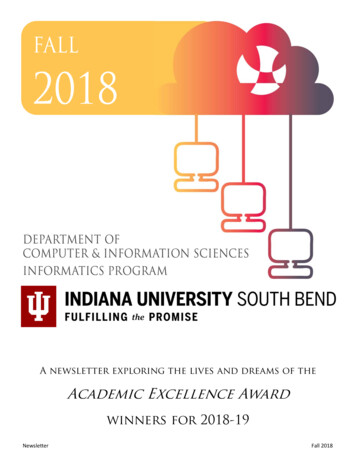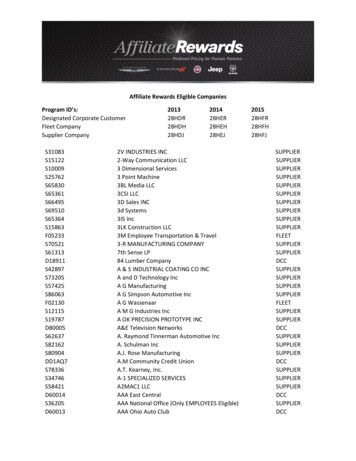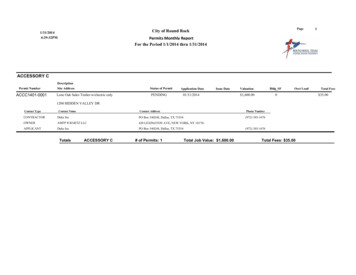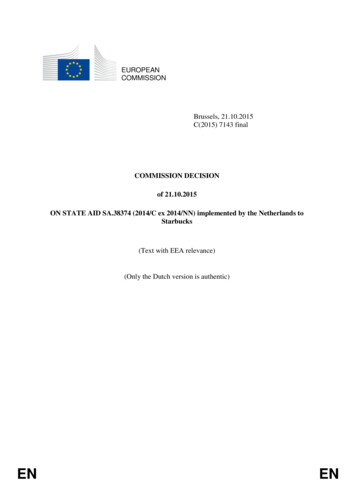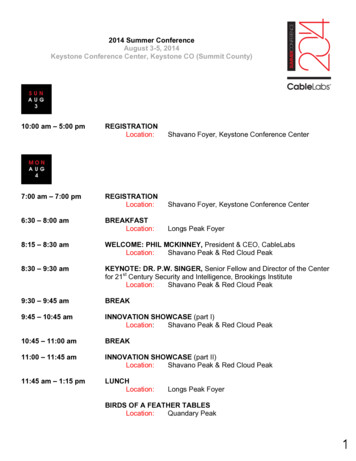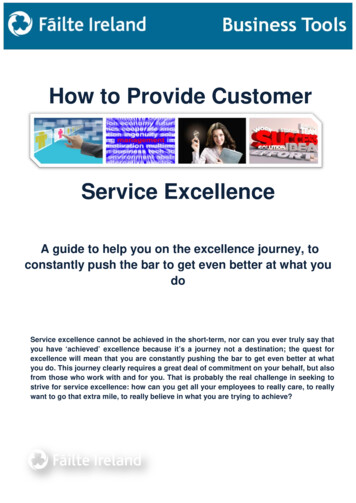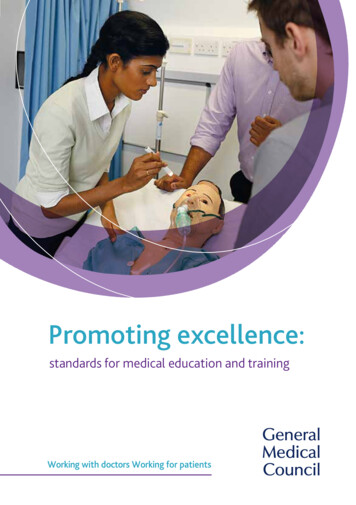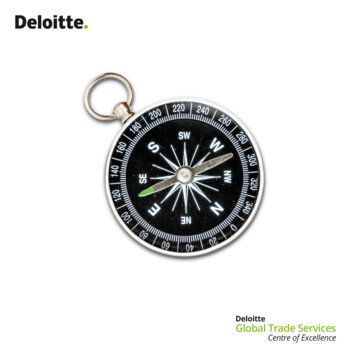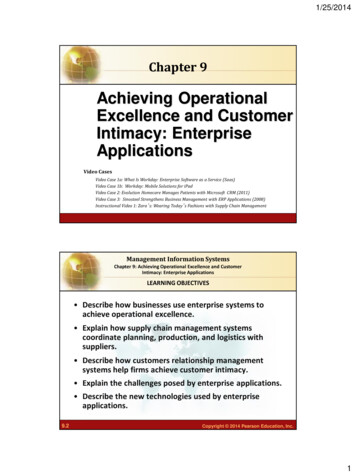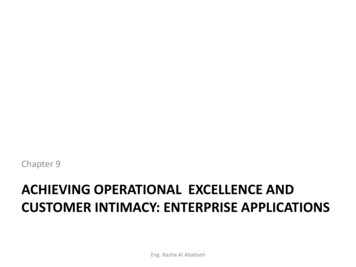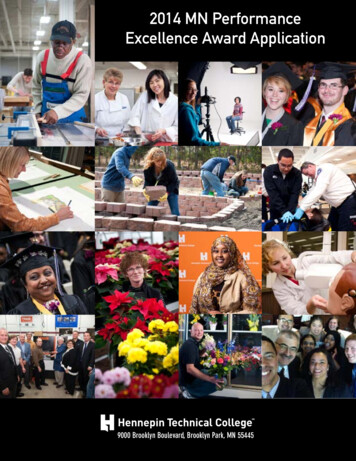
Transcription
2014 MN PerformanceExcellence Award Application9000 Brooklyn Boulevard, Brooklyn Park, MN 55445
Performance Excellence Award ApplicationNovember 2014Table of Contents .AOrganizational Charts. BGlossary . PJourney Chart . TOrganziational Profile .iP.1-1 Academic Awards .iP.1-2 Mission, Vision, Values . iiP.1-3 Core Competencies . iiP.1-4 Staffing By Group . iiP.1-5 Employee Ethnicity Trend . iiiP.1-6 College Bargaining Units. iiiP.1-7 Regulatory Requirements. iiiP.1-8 Key Customer Requirements .ivP.1-9 Key Stakeholder Requirements .ivP.2-1 Strategic Advantages & Challenges .vP.2-2 Performance Improvement System .vCategory One: Leadership.1Fig. 1.1-1 Communication Methods .2Fig. 1.2-1 Data Reviewed by Program Faculty .3Fig. 1.2-2 Program Accreditation & Certification.4Fig. 1.2-3 Key Communities.5Category Two: Strategic Planning .6Fig. 2.1-1 WIN Day Innovation.6Fig. 2.1-2 Key Work Systems . 8-9Fig. 2.1-3 Vision 2020 Progress Report.9Fig. 2.1-4 Vision 2020 Strategic Plan.10Fig. 2.2-1 Projected Performance .13Category Three: Customer Focus .15Fig. 3.1-1 Listening Methods by Key Customer Group .15Fig. 3.1-2 Documenting Dissatisfaction.17Category Four: Measurement, Analysis, and Knowledge Management.19Fig. 4.1-1 Assessments to Obtain Customer Data . 19-20Fig. 4.2-1 Data Source and Distribution .22Fig. 4.2-2 Resources & Technologies for Managing Data .23Category Five: Workforce Focus .25Fig. 5.1-1 Benefits by Job Classification .28Fig. 5.2-1 Learning & Development .30Fig. 5.2-2 Career Progression .30Category Six: Operations Focus.31Fig. 6.1-1 New Program Development Process . 31-32Fig. 6.1-2 Crosswalk Between Work Processes & Core Competencies .32Fig. 6.1-3 Alignment of Processes, Measures, & Linkages to Programs & Services . 32-34Fig. 6.1-4 Key Work Processes .34Fig. 6.2-1 Supply Chain Management.36Category Seven: Results.37Table of ContentsA
Performance Excellence Award ApplicationNovember 2014Glossary3Ps: Policies, Procedures, and PracticesAASC: Academic Affairs and Standards CouncilABE: Adult Basic EducationADA: American with Disabilities ActAFSCME: American Federation of State, County, and Municipal EmployeesAI: Appreciative InquiryALC: Area Learning CenterAQIP: Academic Quality Improvement ProgramATC: Anoka Technical College (MnSCU System)AWP: Annual Work PlanBOT: Board of TrusteesBPC: Brooklyn Park CampusC.A.R.E.: Campus Assessment, Referral and EducationCAO: Chief Academic OfficerCAS Standards: Council for the Advancement of Standards in Higher EducationCASO: Chief Academic/Student Affairs OfficerCCSSE: Community College Survey of Student EngagementCFI: Composite Financial IndexCFO: Chief Financial OfficerCHRO: Chief Human Resources OfficerCIP: Classification of Instructional ProgramsCLEP: College Level Examination ProgramCOOP: Continuity of Operations PlanCQIN: Continuous Quality Improvement Network provides learning and network opportunities for highereducationCTE: Career and Technical EducationCTS: Customized Training ServicesCT/CE: Customized Training and Continuing EducationD2L: Desire2Learn, HTC’s online delivery platformDEED: Department of Employment and Economic DevelopmentDIG: Data Integrity GroupDOE: U.S. Department of EducationEAP: Employee Assistance ProgramEEC: Employee Engagement CommitteeEEOC: Equal Employment Opportunity CommissionEPC: Eden Prairie CampusEPM11: Enterprise Performance Management, version 11ESL: English as a Second LanguageESOL: English for Speakers of Other LanguagesGlossaryP
Performance Excellence Award ApplicationNovember 2014FERPA: Family Educational Rights/Privacy ActFCI: Facilities Condition IndexFT: Full TimeFTE: Full Time EquivalentFVTC: Fox Valley Technical CollegeFYE: Full Year EquivalentHLC: Higher Learning CommissionHobsons’ CONNECT: CRM for student interactions and dataHobsons’ RETAIN: CRM early alert/student retention softwareHTC: Hennepin Technical CollegeHWC: Health and Wellness CommitteeIHCC: Inver Hills Community College (MnSCU System)Int/Ext: Internal/ExternalIPDP: Individual Personal Development PlanIPEDS: Integrated Postsecondary Education Data Systems administered by National Center for EducationalStatistics (NCES) to provide comparative data.IR: Institutional ResearchIT: Informational TechnologyISRS: Integrated Student Records System – MnSCU data management systemLECJEC: Law Enforcement and Criminal Justice Education CenterLRC: Learning Resource CenterMAAC: Manufacturing Assessment and Advancement CentersMAPE: Minnesota Association of Professional EmployeesMASAP: Master Academic and Student Affairs PlanMCTC: Minneapolis Community and Technical College (MnSCU System)Metro Alliance: A Consortium of 11 Metro area MnSCU SchoolsMSU: Metropolitan State UniversityMMA: Middle Management AssociationMMB: Minnesota Management and BudgetMN: MinnesotaMNCEME: Minnesota Center of Engineering and Manufacturing ExcellenceMnSCU: Minnesota State Colleges and UniversitiesMnTC: Minnesota Transfer CurriculumMOA: Memorandums of AgreementMPTC: Moraine Park Technical CollegeMSCF: Minnesota State College FacultyNAC: North Arkansas CollegeNCC: Normandale Community College (MnSCU System)NCLEX: National Council Licensure ExaminationNILIE PACE: National Initiative for Leadership and Institutional Effectiveness Personal Assessment of theGlossaryQ
Performance Excellence Award ApplicationNovember 2014College EnvironmentNOEL LEVITZ: Survey of Student Satisfaction Inventory administered every 5 yearsOCR: Office of Civil RightsOFI: Opportunity for ImprovementOSHA: Occupational Safety and Health AgencyPA: Program AdvancementPAC: President's Administrative CouncilPACE: Personal Assessment of the College Environment Survey, conducted by National Initiative for Leadershipand Institutional Effectiveness (NILIE), first administered in 2013PDCA: Plan – Do – Check – ActPEN: Performance Excellence NetworkPersistence: Retain, transfer or graduatedPS: Prop ShopPSEO: Post-Secondary Enrollment OptionPT: Part TimeQC: Quality CouncilQM: Quality MattersRCTC: Rochester Community and Technical College (MnSCU System)REPL: Replicated DatabaseSAC: Staff Advisory CouncilSAP: Satisfactory Academic ProgressSC: Safety CommitteeSCTC: St. Cloud Technical and Community College (MnSCU System)SDS: Safety Data SheetsSENSE: Survey of Entering Student EngagementSGC: Shared Governance CouncilSkills USA: National Student Organization formerly known as VICA (Vocational Industrial Clubs of America)SL: Senior LeadersSMES: Subject Matter ExpertsSSS: Student Support Services (TRiO Grant)TALES: Teaching and Learning ExperiencesTPSI: Targeted Succession Planning InitiativeTRiO: Federal TRiO programs: including Educational Talent Search (ETS), GEAR UP, Student Support Services(SSS), and Upward Bound (UB)UFT: Unlimited Full-TimeU.S. DOE: U.S. Department of EducationVCP: Voluntary Compliance ProgramWCTC: Waukesha County Technical CollegeWFC: Workforce CentersWIDS: Worldwide Instructional Design SystemGlossaryR
Performance Excellence Award ApplicationNovember 2014WIN: What's Important Now DayWTC: Western Technical CollegeGlossaryS
Performance Excellence Award ApplicationOrganizational ProfileP.1 Organizational DescriptionHennepin Technical College (HTC) was founded in1972 and is Minnesota’s largest technical college.The College serves more than 21,000 students atcampuses in Brooklyn Park (BPC) and Eden Prairie(EPC). Approximately 9,609 students are enrolled incredit courses and 12,087 in non-credit courses. HTCis a member of the Minnesota State Colleges andUniversities system (MnSCU). MnSCU is comprisedof 31 institutions including 24 two-year colleges andseven state universities. MnSCU is governed by a 15member Board of Trustees (BOT) appointed by theGovernor and confirmed by the State Senate.The College provides affordable tuition, qualityinstruction, and hands-on training in outstandingfacilities with state-of-the-art equipment. The Collegeembraces quality and innovation in career andtechnical education, workforce development andlifelong learning.HTC students principally come from countiesthroughout the Minneapolis-St. Paul area andparticularly the western metropolitan area. The twocampuses are strategically located to provide accessto students and industry partners in the highestgrowth areas of the state. As an example, the Collegedraws from three of the fastest growing counties inMinnesota (MN): Scott, Carver, and Wright.P.1a Organizational EnvironmentP.1a(1) Educational Programs and ServicesHTC offers more than 45 credit-based programs ofstudy leading to certificates, diplomas, and degrees[Figure P.1-1]. Programs focus on Manufacturing andEngineering Technology, Public Safety and Services,Media Communications, Transportation, Businessand Information Technology, Construction andBuilding, Floral, Culinary Arts, Landscape andHorticulture, Health Careers and a comprehensive setof General Education coursework. The largestprograms by enrollment include InformationTechnology, Practical Nursing, Law Enforcement,Machine Trade and Automotive Technician. Over 40cutting-edge, non-credit programs are availablethrough Customized Training Services (CTS). Thesecustomized programs offer a variety of servicesincluding industry outreach, training assessmentservice, curriculum and training development.Innovative customized delivery includes on-siteSimulation Learning and a Mobile Simulation trailerfor fire, EMS, and healthcare training.HTC seeks academic program advisory committees’input as quality new programs are designed to meetthe ever-changing workforce needs. As an example,Organizational ProfileNovember 2014collaboration with advisory committee membersresulted in the development of the first-everCommunity Paramedic training program in the U.S.Graduates from this program, all experiencedparamedics, help to fill the ever-widening gaps in thehealth care delivery system by expanding access tohealth care for underserved groups in MN. Currentnew program development is focused on emergingcareers and technology, such as BiomedicalManufacturing, Alternative Fuels Technician, as wellas incorporating green, sustainable and renewableenergy concepts into programs and daily practices.The College is intentional in developing keypartnerships that lead to innovative customized andcredit programs designed to serve the unemployedand underemployed. As an example, HTC workedwith employers, workforce developmentprofessionals, Adult Basic Education (ABE) andindustry associations to create the award-winning MPowered program. Since 2004, the M-Poweredprogram has addressed the critical shortage ofworkers in advanced precision manufacturingthrough a collaborative effort that prepares nontraditional MN job seekers and incumbent workersfor high-demand manufacturing careers.Through a partnership between Metropolitan StateUniversity (MSU) and HTC, the Law EnforcementCriminal Justice Education Center (LECJEC) offerscollaborative programming for law enforcement,criminal justice, fire and first responder programs.Together, these partners educate the majority ofstudents attending college in MN in the fields ofpublic safety and security.HTC offers day, evening and weekend classes.Instruction is delivered through a variety of methodsincluding face-to-face, online, blended learning,state-of-the-art applied labs and clinical andinternships with industry partners. Virtual andsimulation training is offered across programs.Academic AwardsAssociate of Applied Science (A.A.S.)Associate of Science (A.S.)DiplomasCertificatesFigure P.1-1 – Academic AwardsCultivating positive and productive studentrelationships is a college priority, especially early inthe student‘s career. Student Support Services arefocused on student persistence and success. In the lastthree years HTC has actively pursued and receivedfour grants from the U.S. Department of Education(US DOE). These grants complement existingStudent Support Services and provide additionali
Performance Excellence Award Applicationsupport services focused on underrepresentedpopulations. Faculty is engaged in pro-activeadvising activities, which work to provide early,intensive intervention, and support designed toincrease retention and empower students to succeed.HTC actively engages non-traditional and underrepresented students through outreach.Every time the student is in contact with a member ofthe college community, it cumulatively affects thenature of that student‘s relationship with the Collegeand ultimately, their satisfaction and overall success.Student engagement is encouraged through studentgovernment and student clubs such as Skills USA.P.1a(2) Vision and MissionIn fall of 2010, students, faculty, staff, andcommunity/business/education leaders joinedtogether to create the College’s strategic plan Vision 2020 – a collective perspective that identifiesstrategic directions that emboldens the College’senthusiasm to transform challenges into richopportunities and attainable goals. HTC utilizes thestrategic directions to establish annual goals inalignment with MnSCU’s strategic framework. Everytwo years the College brings all employees togetherat What’s Important Now (WIN) Day to identifystrengths and opportunities, and to review thestrategic plan.HTC’s commitment to deliver quality and innovativecareer technical education was reaffirmed in anupdated 2010 mission statement [Figure P.1-2]. Thiscommitment to Technical Education was done in anatmosphere in which many MnSCU TechnicalCollege’s were transitioning to ComprehensiveColleges. Technical and general education facultywork collaboratively with industry advisorycommittees to ensure that program curriculum isbased on standards that prepare students withknowledge and skills to meet the changing needs ofthe workplace. In addition, faculty work with two andfour-year academic partners to create pathways thatsupport student’s academic and professional goals.MissionVisionValuesTo provide excellence in career andtechnical education for employment andadvancement in an ever-changing globalenvironment.Embracing quality and innovation incareer and technical education, workforcedevelopment, and lifelong learning.Trust, Integrity, Pride, Passion, Respect,Collaboration, Innovation, ContinuousImprovement that Fosters Quality Service,Diversity, Employee Engagement, StudentSuccess.Figure P.1-2 – Mission, Vision, ValuesOrganizational ProfileNovember 2014HTC is a gateway to education. Students come to theCollege to create a vision for themselves and tocreate opportunities for earning potential. Lifelonglearning is a demonstrated reality through HTC’score competencies [Figure P.1-3]. People leave withactual skills and can get a job as a result. Core CompetenciesHigh-Tech Career PreparationReal-Life Skill Development Linked to EmploymentState-of-the-Art EquipmentLargest Array of Cutting-Edge Technical Programs in MNNon-Traditional Access and PathwaysFigure P.1-3 – Core Competen
Hobsons’ CONNECT: CRM for student interactions and data Hobsons’ RETAIN: CRM early alert/student retention software HTC: Hennepin Technical College HWC: Health and Wellness Committee IHCC: Inver Hills Community College (MnSCU System) Int/Ext: Int
